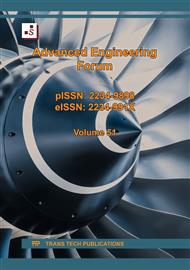[1]
Gunawan, R. S. Gautama, M. S. Abfertiawan, G. J. Kusuma, Y. Lepong, and Saridi, "Penelitian dan Sistem Pengelolaan Air Asam Tambang di Lati Mine Operation," in Seminar Air Asam Tambang ke-5 dan Pascatambang di Indonesia Bandung, 28 Oktober 2014, 2014, no. 28 Otober 2014, p.1–10, https://www.researchgate.net/publication/268819214
DOI: 10.29244/jpsl.9.3.566-576
Google Scholar
[2]
A. Parbhakar-Fox and B. G. Lottermoser, "A critical review of acid rock drainage prediction methods and practices," Miner. Eng., vol. 82, p.107–124, 2015, http://espace.library.uq.edu.au/view/UQ:7abfeb5
DOI: 10.1016/j.mineng.2015.03.015
Google Scholar
[3]
I. Noor, Y. F. Arifin, B. J. Priatmadi, and A. R. Saidy, "Development of the Swampy forest system for passive treatment of acid mine drainage during post-mining land reclamation : A new concept review," Ecol. Environ. Conserv. - EM Int., vol. 26, no. 2, p.901–909, 2020. http://www.envirobiotechjournals.com/EEC/v26i220/EEC-66.pdf
DOI: 10.1038/s41598-023-32990-x
Google Scholar
[4]
F. A. Sekarjannah, S. S. Wardoyo, and Y. W. Ratih, "Management of mine acid drainage in a constructed wetland using hyacinth plant and addition of organic materials," J. Degrad. Min. Lands Manag., 2019
DOI: 10.15243/jdmlm.2019.064.1847
Google Scholar
[5]
J.E. Holland, A. Bennett, and A. Newton. "Liming Impacts on Soils, Crops and Biodiversity in the UK: A Review." Science of the Total Environment 610–611 (2018). http://dx.doi.org/
DOI: 10.1016/j.scitotenv.2017.08.020
Google Scholar
[6]
C. D. McCullough, "Rehabilitation of Lake Kepwari : a Previously Acidic Mine Lake in Western Australia," p.346–351, 2016.
Google Scholar
[7]
M.R. Fikri, Y.F. Arifin, S. Bakri, and I. Noor. Growth Quality and Metal Uptake Ability of Gempol (Nauclea Orientalis L) on Post Mining Area" Jurnal Hutan Tropis (in Bahasa: Kualitas Hidup dan Kemampuan Daya Serap Logam Tanaman Gempol (Nauclea Orientalis L.) pada Areal Pascatambang, Jurnal Hutan Tropis) 10(2): 193 (2022) https://ppjp.ulm.ac.id/journal/index.php/jht/article/view/14129/8293
DOI: 10.20527/jht.v10i2.14129
Google Scholar
[8]
C. D. McCullough, "Approaches to remediation of acid mine drainage water in pit lakes," Int. J. Mining, Reclam. Environ., vol. 22, no. 2, p.105–119, 2008.
DOI: 10.1080/17480930701350127
Google Scholar
[9]
I. Noor, Y. F. Arifin, B. J. Priatmadi, and A. R. Saidy, "Laboratory simulation of the swampy forest system for the passive treatment of acid mine drainage in coal mine reclamation areas," Sci. Rep., vol. 13, no. 1, p.1–10, 2023.
DOI: 10.1038/s41598-023-32990-x
Google Scholar
[10]
S. Suhernomo, L. Fatah, A. R. Saidy, B. J. Priatmadi, I. Noor, and D. Triwibowo, "Strategies of water flow treatment of Paringin Pit Lake to meet wastewater discharge compliance," J. Degrad. Min. Lands Manag., vol. 10, no. 4, p.4683–4695, 2023, doi:10.15243/ jdmlm.2023.104.4683.
DOI: 10.15243/jdmlm.2023.104.4683
Google Scholar
[11]
H. Indra, Y. Lepong, F. Gunawan, and M. S. Abfertiawan, "Penerapan Metode Active dan Passive Treatment Dalam Pengelolaan Air Asam Tambang Site Lati," in Seminar Air Asam Tambang ke-5 dan Pascatambang di Indonesia, 2014, p.1–9, https://www.researchgate.net/ publication/268819107
DOI: 10.29244/jpsl.9.3.566-576
Google Scholar
[12]
N. D. Takarina and T. G. Pin, "Bioconcentration Factor (BCF) and Translocation Factor (TF) of Heavy Metals in Mangrove Trees of Blanakan Fish Farm," Makara J. Sci., vol. 21, no. 2, 2017.
DOI: 10.7454/mss.v21i2.7308
Google Scholar
[13]
I. Noor, Y. F. Arifin, B. J. Priatmadi, and A. R. Saidy, "Role of the Selected Grass Species in Developing of Swampy Forest System for Passive Treatment of Acid Mine Drainage," Mater. Sci. Forum J., vol. 1025, p.273–278, 2021, https://doi.org/10.4028/www.scientific.net/ MSF.1025.273
DOI: 10.4028/www.scientific.net/msf.1025.273
Google Scholar
[14]
L. Tong, R. Fan, S. Yang, and C. Li, "Development and Status of the Treatment Technology for Acid Mine Drainage," Mining, Metall. Explore., vol. 38, no. 1, p.315–327, 2020.
DOI: 10.1007/s42461-020-00298-3
Google Scholar
[15]
J.S. Thullen, J.J. Sartoris, and S.M. Nelson, "Managing vegetation in surface-flow wastewater-treatment wetlands for optimal treatment performance," in Ecological Engineering, 2005.
DOI: 10.1016/j.ecoleng.2005.07.013
Google Scholar
[16]
S. N. Muhammad, F. M. Kusin, M. S. M. Zahar, N. Halimoon, and F. M. Yusuf, "Passive Treatment of Acid Mine Drainage Using Mixed Substrates: Batch Experiments," Procedia Environ. Sci., vol. 30, p.157–161, 2015.
DOI: 10.1016/j.proenv.2015.10.028
Google Scholar
[17]
Ramadhani, Y. F. Arifin, G. S. Rudy, and I. Noor, "Identification and Quality of Growth the intercropping Species on The Reclamation Area of PT Jorong Barutama Greston," Sylva Sci., vol. 05, no. 2, p.307–312, 2022.
DOI: 10.20527/jss.v5i2.5368
Google Scholar
[18]
N.I. Said. "Coal Mine Acid Water Treatment Technology 'Alternative Selection of Technology (in Bahasa: Teknologi Pengolahan Air Asam Tambang Batubara 'Alternatif Pemilihan Teknologi)" JAI 7(2). (2014)
DOI: 10.29122/jai.v7i2.2411
Google Scholar
[19]
G. J. Zagury, V. I. Kulnieks, and C. M. Neculita, "Characterization and reactivity assessment of organic substrates for sulfate-reducing bacteria in acid mine drainage treatment," Chemosphere, 2006.
DOI: 10.1016/j.chemosphere.2006.01.001
Google Scholar
[20]
M. A. Maine et al., "Sustainability of a constructed wetland faced with a depredation event," J. Environ. Manage., 2013.
DOI: 10.1016/j.jenvman.2013.04.054
Google Scholar
[21]
C. D. McCullough, M. Schultze, and J. Vandenberg, "Realizing beneficial end uses from abandoned pit lakes," Minerals, vol. 10, no. 2, p.1–21, 2020.
DOI: 10.3390/min10020133
Google Scholar


